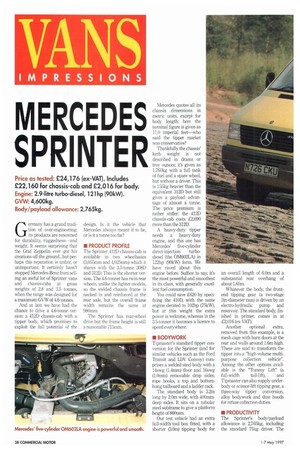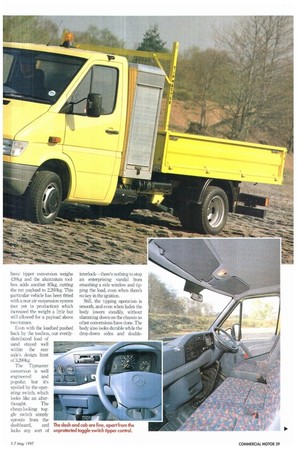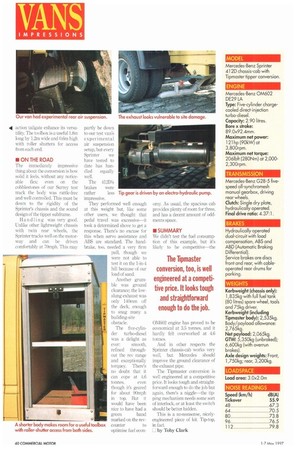MERCEDES
Page 40

Page 41

Page 42

If you've noticed an error in this article please click here to report it so we can fix it.
SPRINTER
Price as tested: £24,176 (ex-VAT). Includes £22,160 for chassis-tab and £2,016 for body. Engine: 2.9-litre turbo-diesel, 121hp (90kW). GVW: 4,600kg.
Body/payload allowance: 2,765kg.
Germany has a grand tradition of over-engineering: its products are renowned for durability, ruggedness—and weight. It seems surprising that the Graf Zeppelin ever got his creations off the ground...but perhaps this reputation is unfair, or unimportant. It certainly hasn't stopped Mercedes-Benz from selling an awful lot of Sprinter vans and chassis-cabs at gross weights of 2.8 and 3.5 tonnes, when the range was designed for a maximum GVW of 4.6 tonnes.
And at last we have had the chance to drive a 4.6-tonne version: a 412D chassis-cab with a tipper body, which promises to exploit the full potential of the design. Is it the vehicle that Mercedes always meant it to be, or is it a tonne too far?
• PRODUCT PROFILE The Sprinter 412D chassis-cab is available in two wheelbases (3,055mm and 4,025mm) which it shares with the 3.5-tonne 3081) and 312D. This is the shorter version. The 4.6-tonner has twin rear wheels, unlike the lighter models, so the welded chassis frame is necked in and reinforced at the rear axle, but the overall frame width remains the same at 980mm.
The Sprinter has rear-wheel drive but the frame height is still a reasonable 715mm. Mercedes quotes all its chassis dimensions in metric units, except for body length; here the nominal figure is given as 11.0 imperial feet—who said the tipper market was conservative?
Thankfully the chassis' kerb weight is not described in drams or troy ounces; it's given as 1,760kg with a full tank of fuel and a spare wheel, but without a driver. This is 155kg heavier than the equivalent 312D but still gives a payload advantage of almost a tonne. The price premium is rather stiffer: the 412D chassis-cab costs £2,690 more than the 31211 A heavy-duty tipper needs a heavy-duty engine, and this one has Mercedes' five-cylinder
direct-injection turbodiesel (the 0M602LA) in 122hp (90kW) form. We have raved about this engine before. Suffice to say, it's the most powerful and smoothest in its class, with generally excellent fuel consumption.
You could save £620 by specifying the 410D, with the same engine derated to 102hp (75kW), but at this weight the extra power is welcome, whereas in the 3.5-tonner it becomes a licence to speed everywhere.
• BODYWORK Tipmaster's standard tipper conversion for the Sprinter (and for similar vehicles such as the Ford Transit and LDV Convoy) comprises a welded steel body with a 14swg (1.4mm) floor and 16swg (1.0mm) removable drop sides, rope hooks, a top and bottomhung tailboard and a ladder rack.
The standard body is 3.2m long by aOm wide, with 400mmdeep sides. It sits on a tubular steel subframe to give a platform height of 860mm.
Our test vehicle had an extra full-width tool box fitted, with a shorter (3.0m) tipping body for an overall length of 6.0m and a substantial rear overhang of about 1.65m.
Whatever the body, the frontend tipping gear (a two-stage 3M-diameter ram) is driven by an electro-hydraulic pump and reservoir. The standard body, finished in primer, comes in at £2,016 (ex-VAT).
Another optional extra, removed from this example, is a mesh cage with barn doors at the rear and walls around 1.6m high. These are said to transform the tipper into a "high-volume multipurpose collection vehicle''. Among the other options available is the "Tommy Lift" (a full-width tail-lift), and Tipmaster can also supply underbody or scissor-lift tipping gear, a three-way tipper conversion, alloy bodywork and dust hoods for refuse collection duties, • PRODUCTIVITY The Sprinter's body/payload allowance is 2,765kg, including the standard 75kg driver. The basic tipper conversion weighs 420kg and the aluminium toolbox adds another 85kg, cutting the net payload to 2,260kg. This particular vehicle has been fitted with a rear air suspension system (not yet in production) which increased the weight a little but still allowed for a payload above two tonnes.
The Tipmaster conversion is well engineered and popular, but it's spoiled by the operating switch, which looks like an after thought. The cheap-looking toggle switch simply sprouts from the dashboard, and lacks any sort of interlock there's nothing to stop an enterprising vandal from smashing a side window and tipping the load, even when there's no key in the ignition.
Still, the tipping operation is smooth, and even when laden the body lowers steadily, without slamming down on the chassis as other conversions have done. The body also looks durable while the drop-down sides and double action tailgate enhance its versatility. The toolbox is a useful I.8m long by 1.2m wide and 0.6m high with roller shutters for access from each end.
• ON THE ROAD The immediately impressive thing about the conversion is how solid it feels, without any noticeable Ilex: even on the cobblestones of our Surrey test track the body was rattle-free and well controlled. This must be down to the rigidity of the Sprinter's chassis and the sound design of the tipper subframe.
Handling was very good. Unlike other lightweight chassis with twin rear wheels, the Sprinter tracks well on the motorway and can be driven comfortably at 70mph. This may partly be down to our test van's experimental air suspension setup, but every Sprinter we have tested to date has han dled equally well.
The 412Us brakes were rather less impressive.
They performed well enough at this weight but, like some other users, we thought that pedal travel was excessive—it took a determined shove to get a response. There's no excuse for this when servo assistance and ABS are standard. The handbrake, too, needed a very firm pull, though we were not able to test it on the 1-in-4 hill because of our load of sand.
Another grumble was ground clearance: the lowslung exhaust was only 140mm off the deck, enough to snag many a building-site obstacle.
The five-cylinder turbo-diesel was a delight as
ever: smooth, refined throughout the rev range and exceptionally torquey. There's r% no doubt that it can cope at 4.6
tonnes, even though it's geared for about 90mph in top. But it would have been nice to have had a green band marked on the rev counter to optimise fuel econ omy. As usual, the spacious cab provides plenty of room for three, and has a decent amount of oddments space.
• SUMMARY We didn't test the fuel consumption of this example, but it's likely to be competitive—the 0M602 engine has proved to be economical at 3.5 tonnes, and it hardly felt overworked at 4.6 tonnes, And in other respects the Sprinter chassis-cab works very well, but Mercedes should improve the ground clearance of the exhaust pipe.
The Tipmaster conversion is well engineered at a competitive price. it looks tough and straightforward enough to do the job but again, there's a niggle—the tipping mechanism needs some sort of interlock, or at least the switch should be better hidden.
This is a no-nonsense, nicelyengineered piece of kit. Tip-top, in fact.
Li by Toby Clark
























































































































